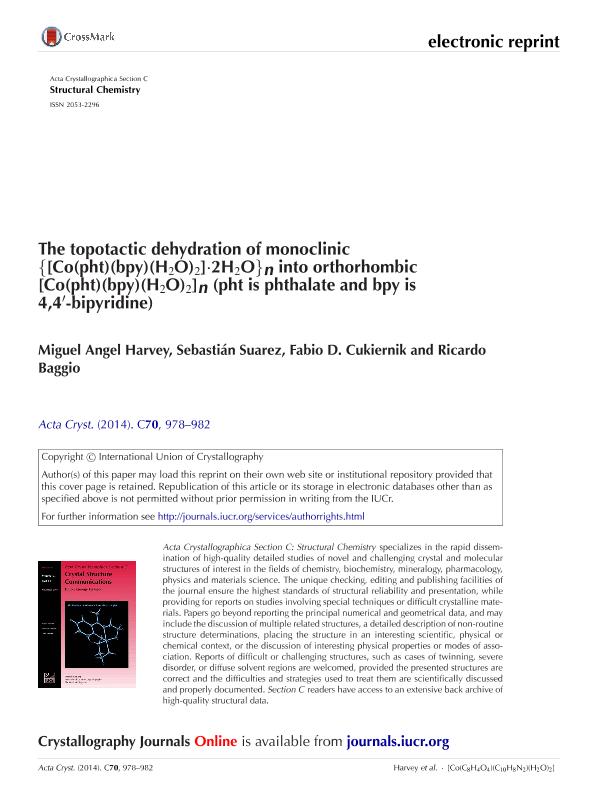Artículo
The topotactic dehydration of monoclinic {[Co(pht)(bpy)(H2O)2]·2H2O}n into orthorhombic [Co(pht)(bpy)(H2O)2]n (pht is phthalate and bpy is 4,4'-bipyridine)
Fecha de publicación:
07/2014
Editorial:
International Union of Crystallography
Revista:
Acta Crystallographica Section C-Crystal Structure Communications
ISSN:
0108-2701
Idioma:
Inglés
Tipo de recurso:
Artículo publicado
Clasificación temática:
Resumen
Controlled heating of single crystals of the previously reported [Köferstein & Robl (2007). Z. Anorg. Allg. Chem. 633, 1127-1130] dihydrate {[Co(pht)(bpy)(H2O)2]·2H2O}n, (II) [where pht is phthalate (C8H4O4) and bpy is 4,4'-bipyridine (C10H8N2)], produced a topotactic transformation into an unreported diaqua anhydrate, namely poly[diaqua([mu]2-benzene-1,2-dicarboxylato-[kappa]2O1:O2)([mu]2-4,4'-bipyridine-[kappa]2N:N')cobalt(II)], [Co(C8H4O4)(C10H8N2)(H2O)2]n, (IIa). The structural change consists of the loss of the two solvent water molecules linking the original two-dimensional covalent substructures which are the `main frame' of the monoclinic P2/n hydrate (strictly preserved during the transformation), with further reaccommodation of the latter. The anhydrate organizes itself in the orthorhombic system (space group Pmn21) in a disordered fashion, where the space-group-symmetry restrictions are achieved only in a statistical sense, with mirror-related two-dimensional planar substructures, mirrored in a plane perpendicular to [100]. Thus, the asymmetric unit in the refined model is composed of two superimposed mirror-related `ghosts' of half-occupancy each. Similarities and differences with the parent dihydrate and some other related structures in the literature are discussed.
Archivos asociados
Licencia
Identificadores
Colecciones
Articulos(INQUIMAE)
Articulos de INST.D/QUIM FIS D/L MATERIALES MEDIOAMB Y ENERGIA
Articulos de INST.D/QUIM FIS D/L MATERIALES MEDIOAMB Y ENERGIA
Citación
Baggio, Ricardo Fortunato; Suarez, Sebastian; Harvey, Miguel Angel; Cukiernik, Fabio Daniel; The topotactic dehydration of monoclinic {[Co(pht)(bpy)(H2O)2]·2H2O}n into orthorhombic [Co(pht)(bpy)(H2O)2]n (pht is phthalate and bpy is 4,4'-bipyridine); International Union of Crystallography; Acta Crystallographica Section C-Crystal Structure Communications; C70; 7-2014; 978-982
Compartir
Altmétricas




